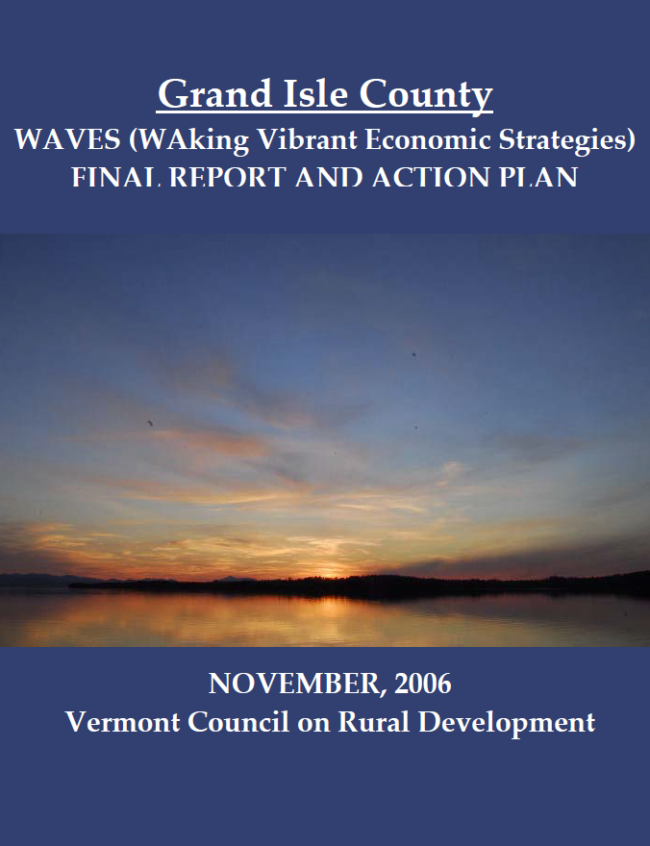A healthy Vermont economy has traditionally relied on a strong sense of heritage, individuals' ingenuity, businesses that always retain their entrepreneurial spirit, and the distinct character of our rural communities. In 2006-2007, with major support from Jane's Trust, VCRD piloted the Creative Communities Program (CCP) to offer an opportunity for towns, villages, and cities around Vermont to use a public participation process to explore ways of combining local culture, community, and commerce for a strong economic future.
This compendium of findings highlights priority topic areas that have emerged through VCRD’s body of work, and considers challenges identified by communities, some of the accomplishments of VCRD at the community and policy level, and unmet community development needs in Vermont. Read the “Rural Development in Vermont: Community & Policy Findings” Report.
VCRD chose the subject of the 2007 Conference based on the growing momentum in Vermont (and globally) to identify our unique local assets and use them as essential building blocks to strengthen our rural economies. VCRD’s 2004 report Advancing the Creative Economy, and the “Creative Communities Program” (CCP) VCRD led over the past two years,…
The Manchester Creative Community Report summarizes the public meetings and brainstorming sessions and lists resources for the following priority projects chosen through the process: Create the Infrastructure for State-of-the-Art Communications Technology; Establish a Local Foods Retail Center; and Establish Manchester as a Leader in Sustainability and Green Business.
The Middlebury Creative Community Report summarizes the public meetings and brainstorming sessions and lists resources for the following priority projects chosen through the process: Establish a Business Incubator; Establish Middlebury as a Pioneer in Alternative Energy Production and Management; Found a Community Creative Economy Umbrella Association; and Make Better Use of the River.
The Richmond Creative Community Report summarizes the public meetings and brainstorming sessions and lists resources for the following priority projects chosen through the process: Develop and Market a Richmond Trails System; Form an Alliance for Creative Development of Existing Properties; and Hold a Harvest Festival to Celebrate Local Agriculture.
The Plainfield Creative Community Report summarizes the public meetings and brainstorming sessions and lists resources for the following priority projects chosen through the process: Establish Plainfield as a Learning Community; Form a Local Creative Economy Association; and Make Downtown Plainfield More Welcoming to Pedestrians.
The Randolph Creative Community Report summarizes the public meetings and brainstorming sessions and lists resources for the following priority projects chosen through the process: Create Stronger Collaborations Around the Creative Economy with an Ongoing Process to Support Creative Economy Projects; Improve Internet Access; and Promote Environmental Initiatives that Define Randolph as a Green Community.
The Bellows Falls Creative Community Report summarizes the public meetings and brainstorming sessions and lists resources for the following priority projects chosen through the process: Provide Year-round Access to Local Foods; Revitalize “The Island”; and Support a Strong Restaurant Culture.
The Johnsbury Creative Community Report summarizes the public meetings and brainstorming sessions and lists resources for the following priority projects chosen through the process: Develop an Eastern Avenue Park (Including Farmers’ Market Site); Highlight Local Cultural Organizations; Improve St. Johnsbury’s Web Presence
The Islands Creative Community Report summarizes the public meetings and brainstorming sessions and lists resources for the following priority projects chosen through the process: Develop Trails to Tour Local Farms, Arts, and Other Islands Highlights; Expand Options for Indoor Community Space; Form a Task Force on Increasing Off-Season Activity




